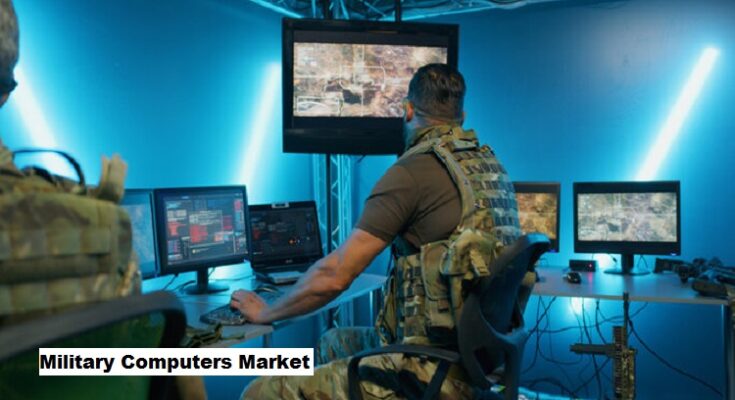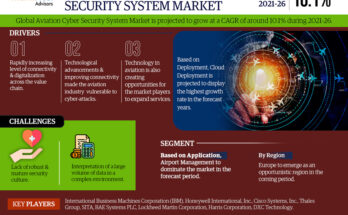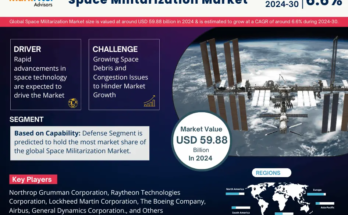The Global Military Computers Market is driven by increasing defense digitization efforts, demanding advanced computing capabilities for command, control, communications, and intelligence applications, coupled with the growing integration of artificial intelligence and automation in military operations.
According to TechSci Research report, “Global Military Computers Market – Industry Size, Share, Trends, Competition Forecast & Opportunities, 2028”, the Global Military Computers Market stood at USD 6.45 billion in 2022 and is anticipated to grow with a CAGR of 5.87% in the forecast period, 2025-2029. The global military computers market is a dynamic and ever-evolving sector that plays a crucial role in the defense industry. It is shaped by constant technological innovation, geopolitical developments, and the persistent demand for enhanced security and efficiency. With advancements in areas such as artificial intelligence, data analytics, and cybersecurity, military computers are becoming more sophisticated and capable of meeting the complex needs of modern defense systems. These cutting-edge technologies enable military organizations to effectively analyze, process, and communicate critical information, thereby strengthening their operational capabilities and decision-making processes. As the global security landscape continues to evolve, the demand for advanced military computers is expected to rise, driving further innovation and growth in this vital industry.
Military computers are not just essential components, but the backbone of any modern defense system. They play a crucial role in a wide range of equipment, including command and control systems, weaponry, surveillance and reconnaissance systems, wearable devices, and vehicles. These advanced computing systems are designed to be robust, reliable, and capable of operating flawlessly even in the most extreme environmental conditions, ensuring seamless functionality and information sharing among military personnel. With their cutting-edge technology and unparalleled performance, military computers empower defense forces to effectively execute missions, maintain situational awareness, and safeguard national security.
The market for military computers is segmented based on platform, type, and region, providing a comprehensive analysis of this industry. The platforms encompass airborne, naval, and ground-based systems, each serving unique purposes in various military operations. When it comes to types of military computers, there are wearable, embedded, and rack-mount options, catering to different requirements and environments. In terms of regional market analysis, North America stands out as the dominant player in the global military computers market, primarily driven by the substantial defense spending by the United States, which fuels technological advancements and innovation in this sector.
The global military computers market is a highly competitive landscape, driven by the existence of numerous large and small-scale manufacturers. Among the top players in this market are renowned companies such as BAE Systems, Thales Group, Saab, and Cobham plc, to name a few. These industry leaders demonstrate their commitment to excellence by making significant investments in research and development. By doing so, they strive to produce cutting-edge and innovative solutions that effectively address the evolving demands of the military sector. Their relentless pursuit of technological advancements ensures that they stay at the forefront of the market, catering to the diverse needs and requirements of armed forces around the world.
Market growth is expected owing to numerous factors. First and foremost, rapid technological advancements across various domains are fueling the demand for advanced battlefield capabilities. The increasing incidences of asymmetric warfare and terrorist activities have also contributed to the need for enhanced military solutions. Additionally, the continuous modernization programs undertaken by defense forces worldwide are driving the market further. It is worth mentioning that the rise of AI and Machine Learning technologies presents new possibilities for the military computing landscape, enabling smarter and more efficient systems. Overall, these factors together create a favorable environment for the growth of the market.
However, the market also faces challenges. The high cost of advanced military computing systems, coupled with budget constraints in several countries, may hinder market growth. Also, issues related to the integration of advanced systems in legacy platforms pose significant challenges.
Browse over market data Figures spread through 180 Pages and an in-depth TOC on “Global Military Computers Market.”
https://www.techsciresearch.com/report/military-computers-market/22565.html
The Global Military Computers Market stands at the forefront of technological innovation, playing a pivotal role in shaping the capabilities of modern defense forces. This market is driven by a confluence of factors, ranging from the evolving nature of military operations to advancements in computing technologies and the imperative of maintaining strategic superiority in an increasingly contested digital environment.
One of the significant trends defining the Global Military Computers Market is the adoption of edge computing in military operations. Edge computing involves decentralized data processing, allowing military computers to analyze information closer to the source of generation. This trend addresses the need for real-time data processing, reduced latency, and enhanced autonomy in decision-making processes. Military computers equipped with edge computing capabilities enable critical applications such as sensor data analysis and situational awareness to be processed locally, optimizing response times and reducing dependence on centralized data centers.
The integration of artificial intelligence (AI) and machine learning (ML) technologies is another transformative trend in the Global Military Computers Market. AI and ML capabilities empower military computers to analyze vast datasets, identify patterns, and make intelligent decisions in real-time. This trend is driven by the increasing complexity of military operations, where the volume and variety of data generated by sensors, communication systems, and intelligence sources necessitate advanced computational analysis. Military computers with AI and ML algorithms enhance the efficiency of data processing, enabling rapid and accurate decision-making, improved situational awareness, and enhanced mission planning.
Cyber resilience and secure computing have emerged as critical considerations in the Global Military Computers Market. As military operations become more digitized, the vulnerability of critical systems to cyber threats rises significantly. The market responds by developing military computers with robust cybersecurity measures, secure boot processes, and hardware-level protection against tampering. This focus on cyber resilience extends beyond traditional cybersecurity measures to include considerations such as supply chain security, hardware-based encryption, and the integration of trusted computing modules.
Modular and upgradeable military computer systems represent a trend aimed at addressing the challenge of rapid technological obsolescence. Military organizations seek computing solutions that can adapt to evolving mission requirements and integrate new technologies without requiring a complete overhaul of existing systems. The trend towards modular military computers features interchangeable components, allowing for the replacement or upgrade of specific modules without affecting the entire system. This flexibility ensures that military computers remain compatible with emerging technologies, address compatibility issues, and support the integration of new features.
Enhanced human-machine interface (HMI) and user experience constitute another significant trend in the Global Military Computers Market. As military operations become more complex and dynamic, the design of intuitive and user-friendly interfaces for military computers becomes imperative. Enhanced HMIs involve the integration of touchscreens, voice recognition, gesture controls, and augmented reality displays. These technologies streamline information access, improve situational awareness, and facilitate faster decision-making in high-pressure scenarios.
In the context of these trends, the Global Military Computers Market faces several challenges that shape its trajectory. Cybersecurity threats and vulnerabilities represent a pervasive challenge, given the increasing frequency and sophistication of cyber attacks. Military computers are prime targets for adversarial entities seeking to compromise the security of critical systems, necessitating continuous innovation in cybersecurity technologies to ensure the integrity, confidentiality, and availability of sensitive information.
Spectrum congestion and electromagnetic interference present operational challenges for military computers operating in diverse and dynamic environments. The finite nature of the electromagnetic spectrum, shared by various military, civilian, and commercial users, requires efficient spectrum management strategies to mitigate interference and optimize communication performance. Military computers must be equipped with communication systems that can dynamically adapt to changing spectral conditions, optimizing bandwidth usage while maintaining secure and interference-resistant communication.
Rapid technological obsolescence poses a significant challenge in the Global Military Computers Market. The pace of technological innovation often outpaces the development and deployment cycles of military systems. Compatibility issues, lack of interoperability with newer technologies, and the inability to incorporate cutting-edge features can lead to premature obsolescence. To address this challenge, military procurement strategies must incorporate flexibility, modularity, and upgradeability in military computer systems, allowing for the integration of new technologies and updates to extend the operational lifespan.
The integration challenges in multi-domain operations highlight the complexity of linking disparate communication systems, platforms, and sensors across diverse operational domains. Achieving seamless interoperability involves the development of communication standards, protocols, and architectures that can support the diverse requirements of air-to-ground, sea-to-land, and space-based communication. The goal is to create a unified communication infrastructure that provides a holistic and integrated approach to military computing.
Limited Size, Weight, and Power (SWaP) constraints present practical limitations for military computers operating in resource-constrained environments. SWaP considerations are particularly critical for applications such as unmanned aerial vehicles (UAVs), soldier-worn systems, and other platforms where size and weight are at a premium. Meeting SWaP constraints requires the development of military computers with advanced thermal management systems, compact form factors, and energy-efficient components.
In conclusion, the Global Military Computers Market is a dynamic landscape shaped by transformative trends and complex challenges. The adoption of edge computing, integration of AI and ML, focus on cyber resilience, emphasis on modular and upgradeable systems, and enhancement of HMIs and user experience collectively redefine the capabilities and resilience of military computing systems. Successfully navigating these trends and challenges is imperative for the market to continue providing armed forces with computing solutions that are adaptive, secure, and capable of meeting the diverse and dynamic requirements of modern defense operations.
Major companies operating in Global Military Computers Market are:
- BAE Systems
- Cobham Plc
- Curtiss-Wright Elbit Systems
- Esterline Technologies
- L-3 Technologies Inc.
- Raytheon Company
- SAAB AB
- Teledyne Technologies
- Thales Group
Download Free Sample Report
https://www.techsciresearch.com/sample-report.aspx?cid=22565
Customers can also request for 10% free customization on this report
“The Global Military Computers Market, at the nexus of technological innovation and defense imperatives, navigates challenges and trends shaping modern warfare. Fueled by edge computing, artificial intelligence integration, and a focus on cybersecurity, military computers are pivotal in enhancing real-time decision-making, communication, and autonomy. Modular designs address rapid obsolescence, while improved human-machine interfaces elevate user experience.
Despite challenges like cybersecurity threats and SWaP constraints, the market thrives on adaptability. As a cornerstone in defense modernization, the Global Military Computers Market stands resilient, providing armed forces with cutting-edge computing solutions essential for navigating the complexities of contemporary security landscapes.” said Mr. Karan Chechi, Research Director with TechSci Research, a research-based management consulting firm.
“Military Computers Market – Global Industry Size, Share, Trends, Opportunity, and Forecast, Segmented By Type (Wearable, Portable), By Application (Air, Naval, Ground), By Region, Competition, 2019-2029”, has evaluated the future growth potential of Global Military Computers Market and provides statistics & information on market size, structure and future market growth. The report intends to provide cutting-edge market intelligence and help decision makers take sound investment decisions. Besides, the report also identifies and analyzes the emerging trends along with essential drivers, challenges, and opportunities in Global Military Computers Market.
Browse Related Reports
Satellite Ground Station Equipment Market
https://www.techsciresearch.com/report/satellite-ground-station-equipment-market/19281.html
Aerospace Robotics Market
https://www.techsciresearch.com/report/aerospace-robotics-market/19282.html
Aircraft Lighting Market
https://www.techsciresearch.com/report/aircraft-lighting-market/19284.html
Contact Us-
TechSci Research LLC
420 Lexington Avenue, Suite 300,
New York, United States- 10170
M: +13322586602
Email: [email protected]
Website: www.techsciresearch.com




